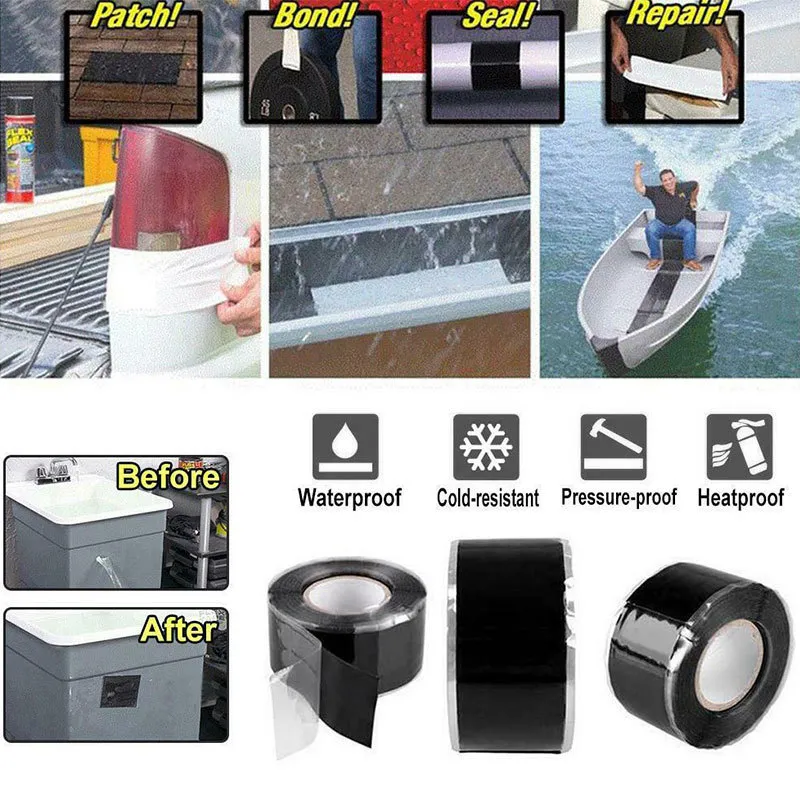Self fusing pipe repair tape is a versatile and essential product designed for both emergency fixes and long-term solutions in plumbing and other industries. This tape is engineered to adhere securely to itself upon application, forming a durable, watertight seal without requiring additional adhesives or tools. Typically composed of silicone or rubber-based materials, it offers excellent elasticity and resilience to various environmental conditions.
Self fusing pipe repair tape main features and functions
Self-Fusing Capability:
Self fusing pipe repair tape bonds tightly to itself when wrapped around pipes or fittings, creating a seamless seal that effectively prevents leaks and withstands pressure fluctuations.High Temperature Resistance:
Withstanding temperatures up to 200°C (392°F), this tape remains stable and reliable in hot environments, making it suitable for industrial applications where heat resistance is crucial.Chemical and Weather Resistance:
The tape exhibits exceptional resistance to chemicals, oils, solvents, and weather elements, ensuring longevity and reliability in diverse conditions. This durability enhances its lifespan and performance across various applications.Easy Application:
Applying self fusing pipe repair tape involves simple steps: clean the surface, wrap the tape around the damaged area while stretching it slightly to activate the self-fusing properties, and firmly press it to ensure a secure bond. Its ease of use makes it ideal for quick repairs in different settings.Versatile Applications:
Beyond pipe repairs, this tape is utilized for electrical insulation, automotive repairs, plumbing emergencies, and more. Its versatility and straightforward application appeal to maintenance professionals, contractors, and DIY enthusiasts alike.

How to use self fusing pipe repair tape?
Surface Preparation: Ensure the surface is clean, dry, and free of grease or debris to facilitate optimal adhesion.
Application: Begin wrapping the tape around the damaged area, slightly stretching it to activate the self-fusing process.
Overlap Layers: Overlap each layer of tape by approximately 50% to ensure complete coverage and a secure seal.
Press and Seal: Press the tape firmly onto itself as you apply it to eliminate air pockets and enhance adhesion.
Curing Time: Allow the tape to cure according to manufacturer instructions, typically forming a complete seal within minutes to hours depending on environmental conditions.

Self fusing pipe repair tape production process
In manufacturing facilities, self fusing pipe repair tape is produced through a controlled process that includes:
Material Selection: Choosing high-quality silicone or rubber-based materials known for their elasticity, durability, and resistance properties.
Mixing and Formulation: Blending the raw materials with additives to achieve specific performance characteristics, such as heat resistance and adhesion.
Extrusion: Extruding the formulated material into a continuous strip of tape, ensuring uniform thickness and quality.
Curing and Cutting: Curing the extruded tape to stabilize its properties and then cutting it into rolls or lengths suitable for packaging.
Quality Control: Implementing stringent quality checks throughout the production process to maintain consistency and ensure the tape meets performance standards.
How to Purchase High-Quality Self Fusing Pipe Repair Tape?
When purchasing self fusing pipe repair tape, consider the following tips to ensure you get a high-quality product:
Material Quality: Check the material specifications to ensure it meets your requirements for temperature resistance, chemical resistance, and durability.
User Reviews: Read customer reviews and testimonials to gauge the tape’s performance in real-world applications and reliability over time.
Certifications: Look for certifications or compliance with industry standards to ensure the tape meets safety and performance criteria.
Supplier Support: Purchase from suppliers or distributors that offer good customer support, warranty options, and technical assistance if needed.

